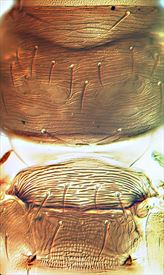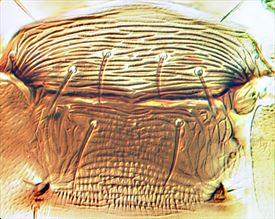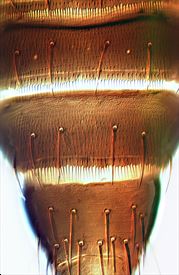Distinguishing features
Both sexes fully winged or micropterous. Female brown, tarsi and apices of tibiae yellow, also antennal segments I–III; fore wing with sub-basal pale band, then brown but paler toward apex. Head with occipital ridge not close to eyes; ocellar triangle with irregular markings; ocellar setae III on anterior margins of triangle; three pairs of postocular setae, median pair long. Antennal segment III slender, sense cone forked but not extending beyond basal fifth of segment IV. Pronotum densely striate, blotch anterior margin deeply emarginate. Metanotal sculpture mainly transverse, with band of microtrichia on posterior fifth. Fore wing with one seta near apex displaced from first vein onto second vein. Tergites I–VIII densely covered with microtrichia, and with complete posteromarginal comb. Sternites with no discal microtrichia medially, sternites III–VII with lobed craspedum medially bearing long microtrichia. Micropterous female with wing lobe shorter than width of thorax; metanotum with microtrichia on more than half of sclerite.
Male similar to female, with small circular pore plate on sternites IV–VII.
Related species
Nine species are currently recognised in this genus, from widely different parts of the world. However, the generic classification is thought to be a poor reflection of phylogeny, and Sericothrips appears to comprise species which show some level of wing-length reduction (Lima & Mound, 2016).
Biological data
Apparently host-specific to the leaves of Ulex europea [Fabaceae], this species has been used as a biological control agent against its weedy host plant in several countries, including New Zealand and Hawaii (Ireson et al., 2008).
Distribution data
Originally from western Europe, but introduced as a biocontrol agent to New Zealand, Hawaii, and Australia (Tasmania, Victoria and South Australia).
Family name
THRIPIDAE, SERICOTHRIPINAE
Species name
Sericothrips staphylinus Haliday
Original name and synonyms
Sericothrips staphylinus Haliday, 1836: 444
References
Ireson JE, Holloway RJ & Chatterton WS (2008) Phenology and development of the gorse thrips, Sericothrips staphylinus Haliday (Thysanoptera: Thripidae), a biological control agent for gorse, Ulex europaeus L. (Fabaceae), in Tasmania. Biological Control 45: 64–71.
Lima EFB & Mound LA (2016) Systematic relationships of the Thripidae subfamily Sericothripinae (Insecta: Thysanoptera) Zoologischer Anzeiger 263: 24–32.




